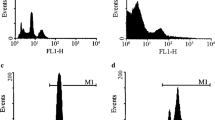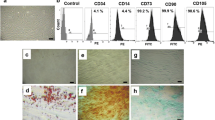Abstract
Purpose
Type 1 diabetes is an autoimmune disease caused by the destruction of β-cells in the pancreas. Bone marrow mesenchymal stem cells are multipotent and easy accessible adult stem cells that may provide options in the treatment of type 1 diabetes. Injured pancreatic extract can promote the differentiation of rat bone marrow mesenchymal stem cells into β-cells. We aimed to observe the effect of quercetin in differentiation and insulin secretion in β-cells.
Methods
Bone marrow mesenchymal stem cells were obtained from the tibiae of rats. Cell surface markers were analyzed by flow cytometry. The cells were treated with rat injured pancreatic extract and quercetin for 2 weeks. Insulin secretion was measured by ELISA. Insulin expression and some islet factors were evaluated by RT-PCR. PDX1, a marker for β-cell function and differentiation, was evaluated by both immunocytochemistry and Western blot. β-cell count was determined by stereology and cell count assay.
Results
ELISA showed significant differences in insulin secretion in the cells treated with RIPE + 20 μM quercetin (0.55 ± 0.01 µg/L) compared with the cells treated with RIPE alone (0.48 ± 0.01 µg/L) (P = 0.026). RT-PCR results confirmed insulin expression in both groups. PDX1 protein was detected in both groups by Western blot and immunocytochemistry. Stereology results showed a significant increase in β-cell number in the RIPE + quercetin-treated cells (47 ± 2.0) when compared with RIPE treatment alone (44 ± 2.5) (P = 0.015).
Conclusions
Quercetin has a strengthening effect on the differentiation of rat bone marrow mesenchymal stem cells into β-cells and increases insulin secretion from the differentiated β-cells in vitro.







Similar content being viewed by others
References
Oh YS (2015) Plant-derived compounds targeting pancreatic beta cells for the treatment of diabetes. Evid-Based Complement Altern Med 2015:12
Sheik Abdulazeez S (2015) Diabetes treatment: a rapid review of the current and future scope of stem cell research. Saudi Pharm J 23(4):333–340
Couri CEB, Voltarelli JC (2009) Stem cell therapy for type 1 diabetes mellitus: a review of recent clinical trials. Diabetol Metabo Syndr 1(1):1–5
Hashemian SJ, Kouhnavard M, Nasli-Esfahani E (2015) Mesenchymal stem cells: rising concerns over their application in treatment of type one diabetes mellitus. J Diabetes Res 2015:675103. doi:10.1155/2015/675103
Wang S, Qu X, Zhao RC (2012) Clinical applications of mesenchymal stem cells. J Hematol Oncol 5(1):1
Wei X, Yang X, Han Z-P, Qu F-F, Shao L, Shi Y-F (2013) Mesenchymal stem cells: a new trend for cell therapy. Acta Pharmacol Sin 34(6):747–754
Ikebe C, Suzuki K (2014) Mesenchymal stem cells for regenerative therapy: optimization of cell preparation protocols. BioMed Res Int 2014:951512
Gabr MM, Zakaria MM, Refaie AF, Khater SM, Ashamallah SA, Ismail AM et al (2015) Differentiation of human bone marrow-derived mesenchymal stem cells into insulin-producing cells: evidence for further maturation in vivo. BioMed Res Int 2015:10
Kim JH, Kim KS, Lee SW, Kim HW, Joo DJ, Kim YS et al (2015) Retinoic acid-induced differentiation of rat mesenchymal stem cells into β-Cell lineage. J Korean Soc Transplant 29(3):118–129
Choi KS, Shin J-S, Lee J-J, Kim YS, Kim S-B, Kim C-W (2005) In vitro trans-differentiation of rat mesenchymal cells into insulin-producing cells by rat pancreatic extract. Biochem Biophys Res Commun 330(4):1299–1305
Xie H, Wang Y, Zhang H, Qi H, Zhou H, Li F-R (2013) Role of injured pancreatic extract promotes bone marrow-derived mesenchymal stem cells efficiently differentiate into insulin-producing cells. PLoS One 8(9):e76056
Oh YS (2015) Plant-derived compounds targeting pancreatic beta cells for the treatment of diabetes. Evidence-Based Complement Altern Med 2015:629863
Ramachandra R, Shetty AK, Salimath PV (2005) Quercetin alleviates activities of intestinal and renal disaccharidases in streptozotocin-induced diabetic rats. Mol Nutr Food Res 49(4):355–360
Coskun O, Kanter M, Korkmaz A, Oter S (2005) Quercetin, a flavonoid antioxidant, prevents and protects streptozotocin-induced oxidative stress and β-cell damage in rat pancreas. Pharmacol Res 51(2):117–123
Vessal M, Hemmati M, Vasei M (2003) Antidiabetic effects of quercetin in streptozocin-induced diabetic rats. Comp Biochem Physiol C Toxicol Pharmacol 135(3):357–364
Youl E, Bardy G, Magous R, Cros G, Sejalon F, Virsolvy A et al (2010) Quercetin potentiates insulin secretion and protects INS-1 pancreatic β-cells against oxidative damage via the ERK1/2 pathway. Br J Pharmacol 161(4):799–814
Hii C, Howell S (1985) Effects of flavonoids on insulin secretion and 45Ca2+ handling in rat islets of Langerhans. J Endocrinol 107(1):1–8
Cho JM, Chang S-Y, Kim D-B, Needs PW, Jo Y-H, Kim M-J (2012) Effects of physiological quercetin metabolites on interleukin-1β-induced inducible NOS expression. J Nutr Biochem 23(11):1394–1402
Prince P, Kamalakkannan N (2006) Rutin improves glucose homeostasis in streptozotocin diabetic tissues by altering glycolytic and gluconeogenic enzymes. J Biochem Mol Toxicol 20(2):96–102
Kim J-H, Kang M-J, Choi H-N, Jeong S-M, Lee Y-M, Kim J-I (2011) Quercetin attenuates fasting and postprandial hyperglycemia in animal models of diabetes mellitus. Nutr Res Pract 5(2):107–111
Brown AR, Covington M, Newton RC, Ramage R, Welch P (1996) The total chemical synthesis of monocyte chemotactic protein-1 (MCP-1). J Pept Sci 2(1):40–46
Doliba NM, Fenner D, Zelent B, Bass J, Sarabu R, Matschinsky FM (2012) Repair of diverse diabetic defects of β-cells in man and mouse by pharmacological glucokinase activation. Diabetes Obes Metab 14(s3):109–119
Bhattacharya S, Oksbjerg N, Young JF, Jeppesen PB (2014) Caffeic acid, naringenin and quercetin enhance glucose-stimulated insulin secretion and glucose sensitivity in INS-1E cells. Diabetes Obes Metab 16(7):602–612
Jeppesen PB, Gregersen S, Poulsen C, Hermansen K (2000) Stevioside acts directly on pancreatic β cells to secrete insulin: actions independent of cyclic adenosine monophosphate and adenosine triphosphate—sensitivie K+ -channel activity. Metabolism 49(2):208–214
Meloni A, DeYoung M, Lowe C, Parkes D (2013) GLP-1 receptor activated insulin secretion from pancreatic β-cells: mechanism and glucose dependence. Diabetes Obes Metab 15(1):15–27
Youl E, Bardy G, Magous R, Cros G, Sejalon F, Virsolvy A et al (2010) Quercetin potentiates insulin secretion and protects INS-1 pancreatic beta-cells against oxidative damage via the ERK1/2 pathway. Br J Pharmacol 161(4):799–814
Mears D, Zimliki CL (2004) Muscarinic agonists activate Ca2+ store-operated and -independent ionic currents in insulin-secreting HIT-T15 cells and mouse pancreatic beta-cells. J Membr Biol 197(1):59–70
Mears D, Zimliki C (2004) Muscarinic agonists activate Ca2+ store-operated and-independent ionic currents in insulin-secreting HIT-T15 cells and mouse pancreatic β-cells. J Membr Biol 197(1):59–70
Mears D (2004) Regulation of insulin secretion in islets of Langerhans by Ca(2+)channels. J Membr Biol 200(2):57–66
Kang G, Holz GG (2003) Amplification of exocytosis by Ca2+-induced Ca2+ release in INS-1 pancreatic beta cells. J Physiol 546(Pt 1):175–189
Dyachok O, Gylfe E (2004) Ca(2+)-induced Ca(2+) release via inositol 1,4,5-trisphosphate receptors is amplified by protein kinase A and triggers exocytosis in pancreatic beta-cells. J Biol Chem 279(44):45455–45461
Islam MS (2010) Calcium signaling in the islets. Adv Exp Med Biol 654:235–259
Ravier MA, Daro D, Roma LP, Jonas JC, Cheng-Xue R, Schuit FC et al (2011) Mechanisms of control of the free Ca2+ concentration in the endoplasmic reticulum of mouse pancreatic beta-cells: interplay with cell metabolism and [Ca2+]c and role of SERCA2b and SERCA3. Diabetes 60(10):2533–2545
Chakravarthy B, Gupta S, Gode K (1982) Functional beta cell regeneration in the islets of pancreas in alloxan induced diabetic rats by (−)-epicatechin. Life Sci 31(24):2693–2697
Kim YJ, Bae YC, Suh KT, Jung JS (2006) Quercetin, a flavonoid, inhibits proliferation and increases osteogenic differentiation in human adipose stromal cells. Biochem Pharmacol 72(10):1268–1278
Wattel A, Kamel S, Prouillet C, Petit JP, Lorget F, Offord E et al (2004) Flavonoid quercetin decreases osteoclastic differentiation induced by RANKL via a mechanism involving NFκB and AP-1. J Cell Biochem 92(2):285–295
Zhang L, Cao Q, Hu Z, Yan X, Wu B (2011) Effect of quercetin on neural stem cell proliferation in the subventricular zone of rats after focal cerebral ischemia-reperfusion injury. Nan fang yi ke da xue xue bao. J South Med Univ 31(7):1200–1203
Acknowledgement
This paper has been extracted from the PhD thesis of Behnoosh Miladpour and was supported by Grant Number 93-7228 from Vice-chancellor for Research Affairs of Shiraz University of Medical Sciences.
Author information
Authors and Affiliations
Corresponding author
Ethics declarations
Conflict of interest
Authors do not have conflict of interest in any aspects of specific financial interests and affiliations.
Ethical approval
All animal experiments were approved by the ethics committee of Shiraz University of Medical Sciences.
Informed consent
No informed consent.
Rights and permissions
About this article
Cite this article
Miladpour, B., Rasti, M., Owji, A.A. et al. Quercetin potentiates transdifferentiation of bone marrow mesenchymal stem cells into the beta cells in vitro. J Endocrinol Invest 40, 513–521 (2017). https://doi.org/10.1007/s40618-016-0592-8
Received:
Accepted:
Published:
Issue Date:
DOI: https://doi.org/10.1007/s40618-016-0592-8




